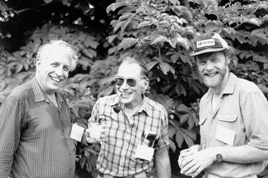1989: Immunological Recognition, Vol. LIV
Organizer: James D. Watson, John R. Inglis
Our 1967 Symposium on antibodies marked the acceptance of the theories advanced by Jerne and Burnet that antigen, on entering the immune system, selected and expanded clones of lymphocytes with immunoglobulin receptors that best fitted the antigen. Yet, even then, it was apparent that this was not a whole explanation. Induction of antibodies to a hapten seemed to require specific recognition of the carrier molecule, not just the hapten. By 1976, and our next immunological Symposium, the separation of lymphocytes into two classes had been established, and for most antibody responses, interaction between T and B cells with separate specificities was known to be necessary. Clearly, the antibody-like membrane receptors of B cells could bind free antigen. The target for T cells, however, seemed to be cell-bound antigen, but only if effector and target cell were identical for genes at the major histocompatibility loci. Although speculation at the Symposium was intense, the nature of the T cell's receptor, and of its ligand, remained mysterious.
Work in the 1980s clarified these events at a molecular level, greatly aided by the advent of monoclonal antibody technology and the ability to clone T cells and manipulate lymphocyte genes. Antigen receptor molecules from T cells were identified and found to be encoded in a unique set of rearranging gene segments, separate from but evolutionarily related to the immunoglobulin genes. The analysis of other cell-surface molecules revealed diversity among T cells that correlated with differences in function. Crucially, it was observed that the products of MHC loci could bind peptide fragments of antigen and deliver them to the surface of antigen-presenting cells. A structural basis for T-cell antigen recognition became apparent when the solution of the crystal structure of the class I histocompatibility molecule HLA-A2 showed it to have a groove in which both peptide and the variable T-cell receptor might bind. X-ray crystallography also shed light on the interaction between an antibody and its ligand, with the solution of the structure of an immune complex.
By 1989, therefore, the time was clearly ripe for another Cold Spring Harbor Symposium on immunology, the third in the series, this time focusing on the molecular, cellular, and structural aspects of immunological recognition. The themes of the meeting were the interactions among MHC molecules, peptides, and T-cell receptors; the shaping of T-cell and B-cell repertoires by these events; and their consequences for lymphocyte activation and tolerance. Our aim was to bring together the leaders in this now very diverse field, and as principal organizers, we benefited greatly by advice from many sources. In particular, we thank Jay Berzofsky, Malcolm Gefter, Tasuko Honjo, Richard Lerner, Philippa Marrack, Fritz Melchers, Matthew Scharff, Susumu Tonegawa, and Don Wiley for their help.
The final program consisted of 114 speakers, and there were 446 participants. Every available
| 
seat in Grace Auditorium was occupied throughout the week, and the aisles overflowed. The meeting opened with splendid presentations from Leroy Hood, Philippa Marrack, Don Wiley, Emil Unanue, and Hugh McDevitt, whose talks highlighted the themes of the coming week. Following 14 sessions of great intensity, Jonathan Howard concluded with an elegant and wide-ranging summary.
Such a meeting requires many sources of financial support; we gratefully acknowledge the help of the National Cancer Institute, the National Institute of Allergy and Infectious Diseases, the National Science Foundation, and the Lucille P. Markey Charitable Trust. Essential funds also came from our Corporate Sponsors: Alafi Capital Company; American Cyanamid Company; Amersham International plc; AMGen Inc.; Applied Biosystems, Inc.; Becton Dickinson and Company; Beecham Pharmaceuticals; Boehringer Mannheim Corpo¬ration; Ciba-Geigy Corporation / Ciba/Geigy Limited; Diagnostic Products Corporation; E.I. du Pont de Nemours & Company; Eastman Kodak Company; Genentech, Inc.; Genetics Institute; Hoffman-La Roche Inc.; Johnson & Johnson; Life Technologies, Inc.; Eli Lilly and Company; Millipore Corporation; Monsanto Company; Oncogene Science, Inc.; Pall Corporation; Perkin-Elmer Cetus Corporation; Pfizer Inc.; Pharmacia Inc.; Schering¬Plough Corporation; Tambrands Inc.; The Upjohn Company; The Wellcome Research Laboratories, Burroughs Wellcome Co.; and Wyeth-Ayerst Research.
Registration and housing for the participants were organized with care and courtesy by the staff of the Meetings Office: Maureen Berejka, Barbara Ward, Karen Otto, Diane Tighe, Michela McBride, and Marge Stellabotte. Jim Hope and his staff provided admirable catering, and once again Herb Parsons and his assistants delivered a flawless audiovisual service, rising to the challenges of double projection (requested by nearly every speaker) and the presentation of a movie. The enormous correspondence required for a Symposium was ably handled by Andrea Stevenson and P.J. Harlow. These books were edited by Dorothy Brown, Patricia Barker, and Ralph Battey, assisted by Joan Ebert, Mary Cozza, and Inez Sialiano, and their production was overseen by Nancy Ford.
— Jan A. Witkowski |